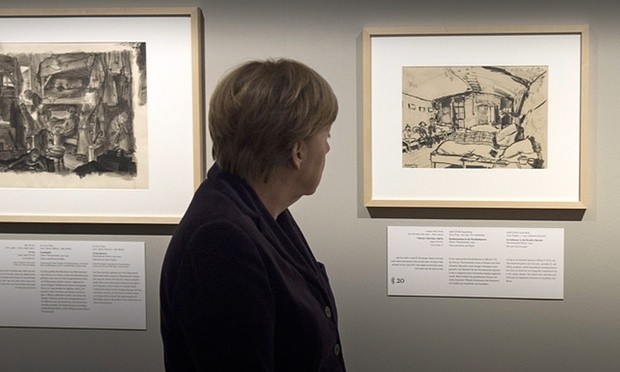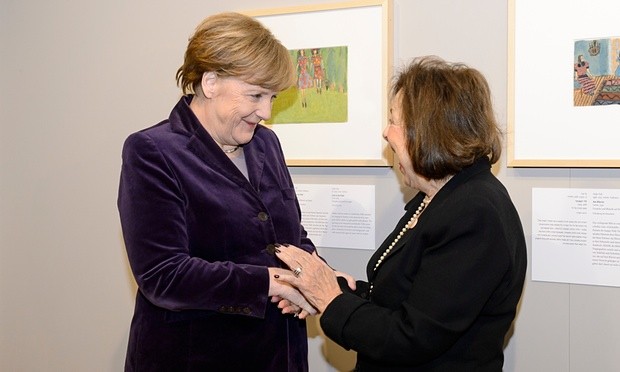Angela Merkel inaugurates Holocaust art gallery amid anti-Semitic warnings
The Guardian
German chancellor says refugees from the Middle East, where hatred of Jews is ‘widespread’, must learn about the Holocaust

The German chancellor, Angela Merkel, has opened a major exhibition in Berlin featuring works by Jewish concentration camp prisoners, as she pledged to combat a feared rise in antisemitism in Germany linked to a record influx of refugees.
The show, Art from the Holocaust, brings together 100 works on loan from Israel’s Yad Vashem memorial. They were created in secret by 50 artists between 1939 and 1945 while they were confined to the camps or ghettos.
Twenty-four of the artists did not survive the second world war.
The drawings and paintings on display at the German Historical Museum depict the suffering, drudgery and terror endured by the detainees.
But about a third of the collection shows artists’ attempts to escape their plight with their imaginations, putting to paper treasured memories and dreams of freedom beyond the barbed wire.
Merkel, looking ahead to Wednesday’s commemorations of the 71st anniversary of the Auschwitz liberation in her weekly video podcast, said such exhibitions served as a crucial tool for educating younger generations.
She cited in particular the fears of German Jewish leaders that the need to impart the lessons of the Holocaust has grown more urgent with the influx of a record 1.1 million asylum seekers to Germany in 2015, many from the Middle East.
“We must focus our efforts particularly among young people from countries where hatred of Israel and Jews is widespread,” she said.
The head of Yad Vashem, Avner Shalev, called the works on loan irreplaceable “treasures”, many of which were hidden by their creators and only discovered after the war.
They are “the expression of human beings under these unique circumstances to try and prevail … above the atrocities and deaths”, he told reporters at a press preview of the exhibition.
“After thinking and rethinking, we thought it might be the right time, the right place, to bring this collection to Germany.”
Merkel noted later at the opening that the collection had been sent to Berlin in two shipments “in case something happened, so that they would not all be damaged”.
“That moved me very much,” she was quoted as saying by German news agency DPA.
The only surviving artist, Nelly Toll, travelled to Berlin from the United States to take part in the opening.

She said she created the two pencil-and-watercolour works when she was six years old and in hiding with her mother in a small room in the home of a Christian family in Nazi-occupied Poland in 1943.
One drawing shows two carefree girls in a sun-dappled field wearing brightly coloured dresses with floral patterns.
The other, By the Piano, depicts a character which she said was inspired by Cinderella and another, a princess, enjoying music together in a well-appointed salon.
Toll said the scene might have been her family’s own living room before they had to flee.
“My memory and my imagination all blended,” she admitted with a smile.
Painting and drawing allowed her to escape the loneliness, boredom and fear in the tiny annexe.
“They were very happy pictures. The figures you see almost became my friends,” she said.
The bulk of the works in the exhibition, however, are stark testimonials to savage treatment at the hands of the SS men and the fragility of daily life.
An artist named Jacob Lipschitz, who survived Dachau, immortalised his brother in a watercolour called Beaten, showing his scabbed and scarred back with his head bowed after a vicious attack by guards.
A wrenching ink drawing by Josef Schlesinger, The Hanging of Nahum Meck, depicts the execution of a prisoner accused of shooting a guard while trying to escape the Kovno ghetto, as other detainees are forced to watch.
Curator Eliad Moreh-Rosenberg said many of the pieces were created in the certainty that they would send a message from the grave.
“The artists were conscious that they were painting for posterity,” she said.
“It was their hope that something would survive for generations to come – to leave a trace.”
How to submit an Op-Ed: Libyan Express accepts opinion articles on a wide range of topics. Submissions may be sent to oped@libyanexpress.com. Please include ‘Op-Ed’ in the subject line.
- Dbeibah backs elections, rejects military rule in Libya - November 23, 2024
- Spanish consumer watchdog levies heavy fines on airlines over unfair fees - November 23, 2024
- Turkish parliament committee backs military agreement with Libya - November 23, 2024


